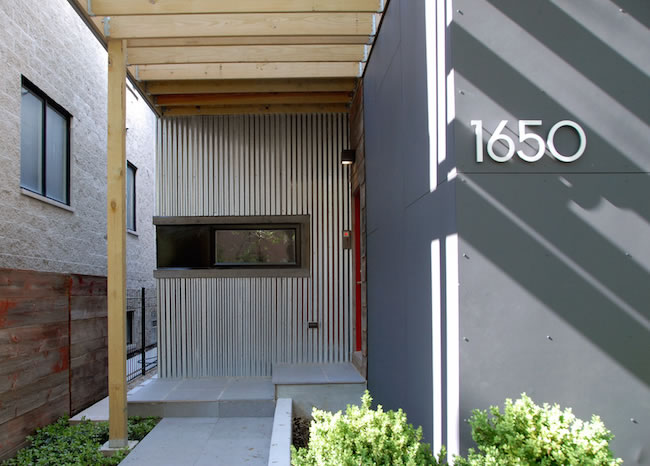Armed with some lessons learned after designing Chicago’s first green prefab house, the C3, Jeffrey Sommers of Square Root Architecture and Design created version 2.0—a hybrid approach to prefab that draws on the best parts of both modular and on-site construction. “This house was a case study on how and why to build better,” says Sommers. The project received EnergyStar and Indoor AirPlus certifications and was third-party tested for a HERS (Home Energy Rating System) score of 43.
SIP SYSTEM
The house was constructed with a structural insulated panel (SIP) system. Generically referred to as a flat-pack, this system used to construct the exterior walls and roof forms a highly insulated thermally broken building envelope with minimal opportunities for air and water infiltration. Although this form of prefab requires more onsite construction, it’s a hybrid approach that takes advantage of the better qualities of both prefab and onsite construction, and minimizes transportation and erection costs of the prefab units. “It allowed for lower shipping costs, lower craning costs, and the ability to work within the city’s requirements for on-site inspections,” Sommers says.
PROJECT
LOCATION Chicago, IL
Size 3,600ft 2
Completion 2013
Certification Energy Star + Indoor Air Quality (IAQ)
Program Single-family residence
Cost $165/ft 2
TEAM
OWNER Private
Architect Square Root Architecture + Design
Structural Engineer Porter SIPs
Mechanical Engineer Priority Energy
Landscape Architect Groundwork Design
General Contractor Villa Builders
Solar Contractor Solar Service
SUPPLIERS
Glass Systems THV Windows
Air/Weather Barrier Enviro Dri
Roofing TPO
HVAC Lifebreath
Cement Board Siding Viroc
Corrugated Metal Siding Galvalume
Wood Siding Reclaimed Barnwood Siding
Kitchen Cabinetry Cabico
HIGH-EFFICIENCY MECHANICALS
“While a lot of buildings are designed according to ‘rule of thumb,’” says Sommers, “we design our systems specific to the energy calculations of the particular building.” Rather than an open-flame furnace, a forced-air system uses hot water coils, allowing the heating/cooling systems to be more efficient because they hold temperature better. Solar thermal panels on the roof produce the hot water that passes through the high-efficiency boiler, supplying both domestic hot water and water for heating. Ductwork throughout was treated with Aeroseal, an expanding aerosol product that seals small leaks, reducing air loss. All mechanicals are organized to one side of the building to maximize construction efficiency and allow the remainder of the floor plan to remain open and flexible.
WATERPROOFING OVER DAMPPROOFING
While most buildings in Chicago feature damp-proofed basements (where an asphalt-based coating is applied to the outside to keep out soil moisture), Square Root chose to waterproof instead, a practice that stops both moisture and liquid water. “It’s a belt and suspenders approach to keeping water out,” Sommers says. A waterproofed membrane runs along the entire concrete foundation and insulates outside the basement wall. “When you’re going from below grade to above grade, microclimates have significant impacts on where dewpoints are. It made more sense to push the R10 insulation outside to keep the wall warmed on the inside and the condensation away,” Sommers says.
BARRIER SYSTEM
Exterior materials include corrugated corten metal siding, painted cement board panels, and reclaimed barn wood siding. In addition to a rainscreen system that allows the siding to breathe, the house features a liquid-based building wrap called Enviro-Dri, a more effective alternative to traditional housewraps. The weather-resistant barrier system is a permanently adhered membrane that is applied directly to the sheathing system. “Since it’s a liquid-applied membrane, there are no seams so you end up with a contiguous membrane around the building,” says Sommers.

Corrugated corten metal siding, painted cement board panels, and reclaimed barn wood siding comprise parts of the exterior.

